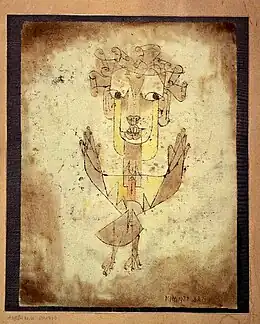Angelus Novus
Angelus Novus (New Angel) is a 1920 monoprint by the Swiss-German artist Paul Klee, using the oil transfer method he invented. It is now in the collection of the Israel Museum in Jerusalem.
| Angelus Novus | |
|---|---|
 | |
| Artist | Paul Klee |
| Year | 1920 |
| Type | monoprint |
| Dimensions | 31.8 cm × 24.2 cm (12.5 in × 9.5 in) |
| Location | Israel Museum, Jerusalem |
History
The artist's friend Walter Benjamin, a noted German critic and philosopher, purchased the print in 1921. In September 1940 Benjamin committed suicide during an attempt to flee the Nazi regime. After World War II, Benjamin's friend Gershom Scholem, a distinguished scholar of Jewish mysticism, inherited the drawing. According to Scholem, Benjamin felt a mystical identification with the Angelus Novus and incorporated it in his theory of the “angel of history,” a melancholy view of historical process as an unceasing cycle of despair.[1]
In the ninth thesis of his 1940 essay “Theses on the Philosophy of History”, Benjamin describes Angelus Novus as an image of the angel of history:
A Klee painting named Angelus Novus shows an angel looking as though he is about to move away from something he is fixedly contemplating. His eyes are staring, his mouth is open, his wings are spread. This is how one pictures the angel of history. His face is turned toward the past. Where we perceive a chain of events, he sees one single catastrophe which keeps piling wreckage upon wreckage and hurls it in front of his feet. The angel would like to stay, awaken the dead, and make whole what has been smashed. But a storm is blowing from Paradise; it has got caught in his wings with such violence that the angel can no longer close them. The storm irresistibly propels him into the future to which his back is turned, while the pile of debris before him grows skyward. This storm is what we call progress.[2]
In 2015, in conjunction with her solo exhibition at the Tel Aviv Museum of Art, American artist R. H. Quaytman discovered that the monoprint had become adhered to an 1838 copperplate engraving by Friedrich Müller after a portrait of Martin Luther by Lucas Cranach.[3][4]
Legacy
The name and concept of Klee's "New Angel" has inspired works by other artists, filmmakers, writers and musicians, including John Akomfrah, Ariella Azoulay, Amichai Chasson, Carolyn Forché, Laurie Anderson, Rabih Alameddine, and Ruth Ozeki.[5][6][7]
In 1997, German art historian Otto Karl Werckmeister included Klee's "New Angel" image among his selection of "icons of the left." He discussed Benjamin's use of the painting as an important contribution to its iconic status.[8]
See also
References
- Angelus Novus at the Israel Museum, Jerusalem
- Benjamin, "Theses on the Philosophy of History", Illuminations, trans. Harry Zohn, New York: Schocken Books, 1969: 249.
- Cotter, Holland (5 November 2015). "R.H. Quaytman's Variations on Klee's Angel". The New York Times.
- Quaytman, R. H. (2015). חקק, Chapter 29. Tel Aviv Museum of Art. ISBN 978-965-539-121-3.
- "Last Angel of History". 2013. Archived from the original on 9 May 2013. Retrieved 20 May 2016.
- "zing6 - reviews - angelus nova". Zing Magazine. 1997. Archived from the original on 4 October 2008. Retrieved 9 October 2012.
- "Seventh Munchener Biennale". 4–19 May 2000. Retrieved 9 October 2012.
- Werckmeister, Icons of the Left: Benjamin and Einstein, Picasso and Kafka After the Fall. Chicago: University of Chicago Press, 1997: 9.
External links
 Media related to Angelus Novus at Wikimedia Commons
Media related to Angelus Novus at Wikimedia Commons